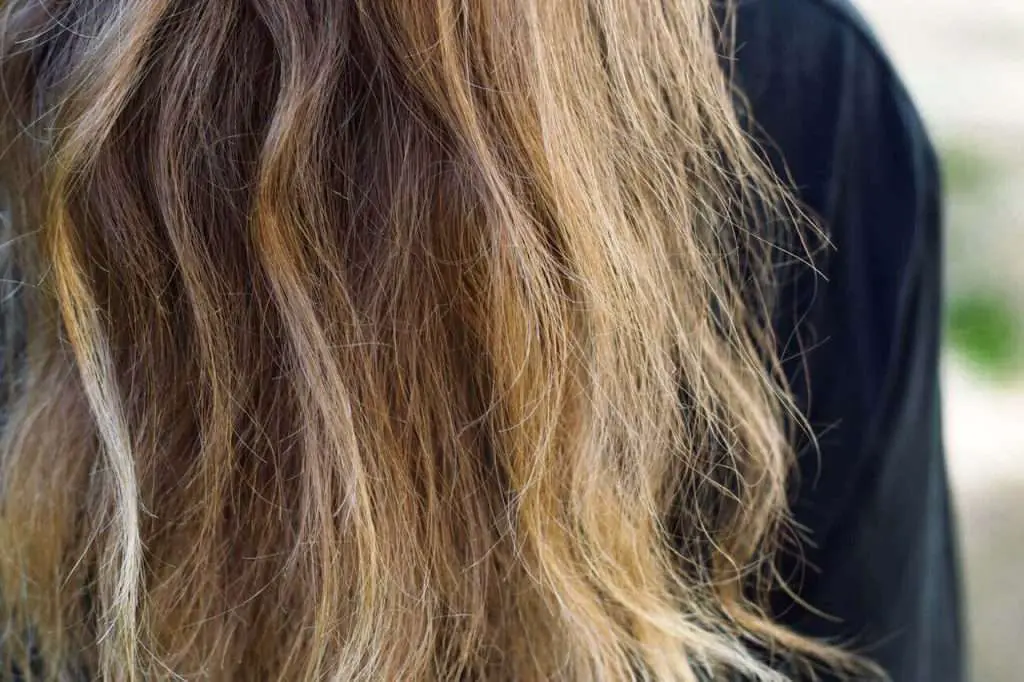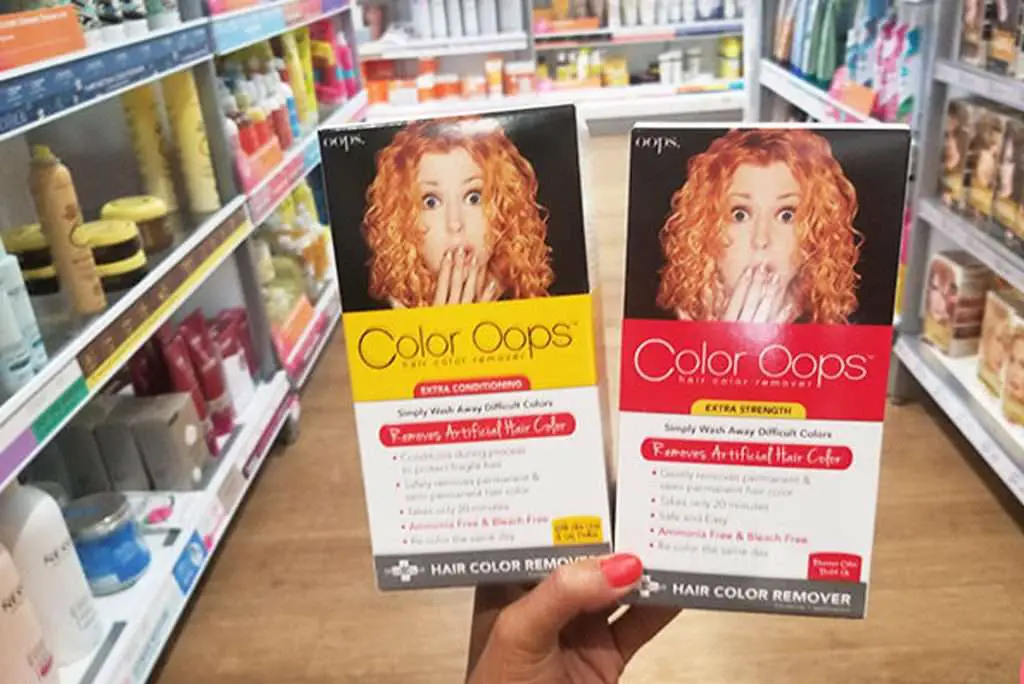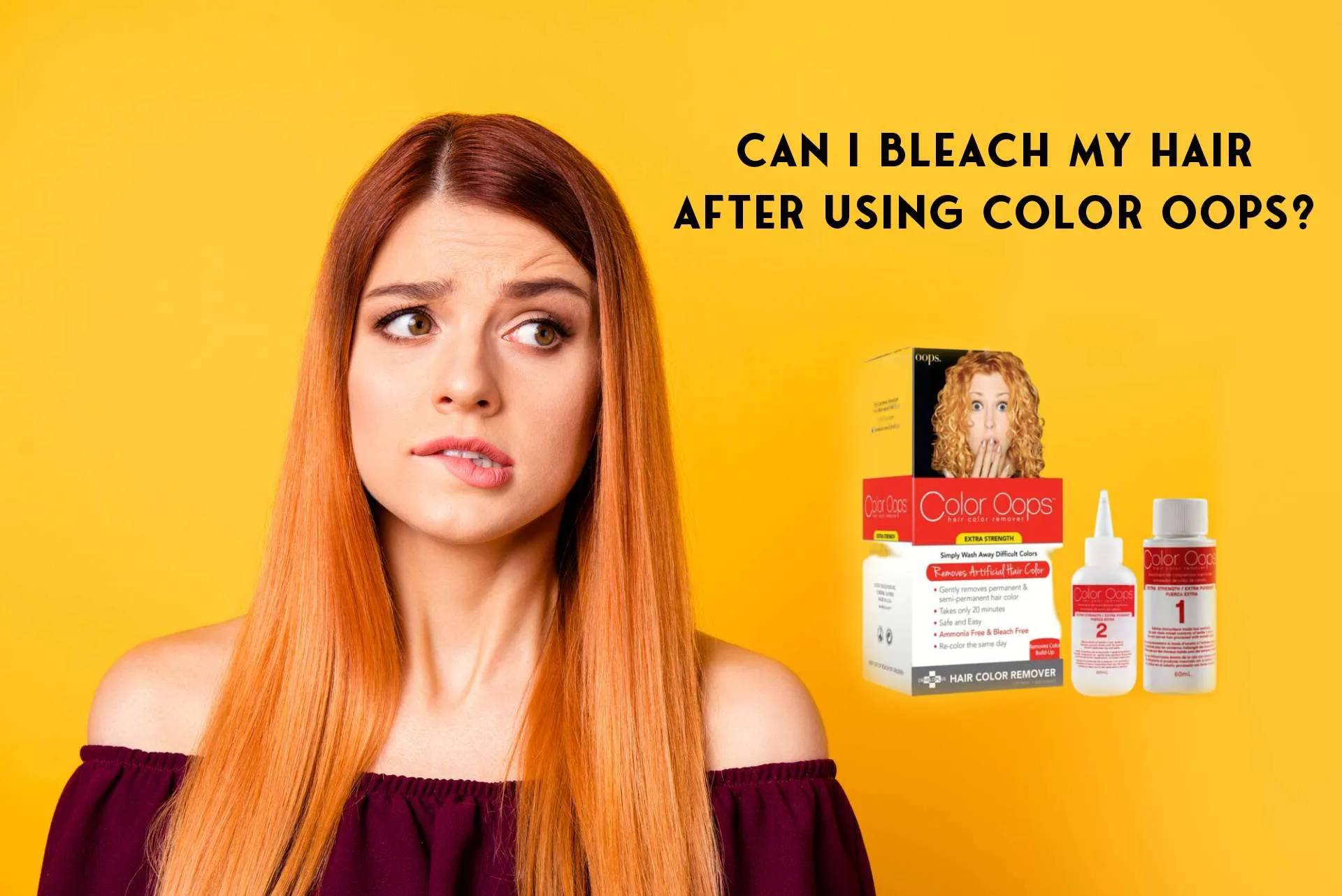Table of Contents
Welcome to our comprehensive guide where we unravel the truth about bleaching your hair after using Color Oops. If you’ve found yourself in a hair color predicament and are considering bleaching as a potential solution, you’re in the right place.
In this article, we’ll provide you with valuable personal insights, expert advice, and best practices to ensure you make informed decisions regarding your hair. So, let’s dive right in!
You may also read: 10 Color Oops Reviews and Experiences: Is Color Oops the Best Hair Color Remover?
My Personal Encounter with Color Oops

The Great Color Oops Experiment Gone Wrong
It was a sunny afternoon, and I decided it was time for a hair color change. Eager to try a vibrant new shade, I reached for Color Oops, a popular color remover. Little did I know that this seemingly innocent decision would lead to an unexpected turn of events. Join me as I recount my hair transformation misadventure.
Have you ever found yourself in a situation where you wanted to change your hair color but ended up regretting it? Well, that’s exactly what happened to me when I decided to use Color Oops.
As someone who loves experimenting with different hair colors, I thought using a color remover would be the perfect solution to start fresh and achieve my desired shade. Little did I know that it would be a decision I would soon come to regret.
You may also read: Color Oops After Bleach: A Complete Guide to Rescuing Your Hair Color!
After carefully following the instructions on the Color Oops package, I applied the product to my hair, excitedly anticipating the removal of the old color and the blank canvas it would provide for my new hue.
However, as the color remover started working its magic, I noticed that my hair didn’t turn out as expected. Instead of a clean slate, my hair had an uneven and patchy appearance, with some areas appearing lighter than others.
Confused and disappointed, I turned to the internet for answers. It was then that I discovered that Color Oops can have unpredictable results, especially if the previous hair color had been applied multiple times or contained stubborn pigments.
This knowledge left me in a dilemma. I still wanted to achieve the new hair color I had in mind, but I wasn’t sure if it was safe to proceed with bleaching my hair after using Color Oops.
Understanding Color Oops and its Effects
What Happens to Your Hair When You Use Color Oops?
Before we delve into the question of whether it’s safe to bleach your hair after using Color Oops, let’s take a moment to understand the product itself and its effects on your hair.
Color Oops is a color remover that works by shrinking the artificial dye molecules in your hair, allowing them to be washed out. It’s important to note that Color Oops does not restore your hair to its natural color but rather creates a blank canvas by removing the artificial color.
During the color removal process, Color Oops opens up the hair cuticles, making them more porous. This increased porosity can affect how your hair absorbs and reacts to subsequent chemical treatments, such as bleaching. It’s crucial to consider the condition of your hair after using Color Oops before deciding to proceed with any further chemical processes.
The Bleaching Conundrum
Can I Safely Bleach My Hair After Color Oops?
Now comes the crucial question: Is it safe to bleach my hair after using Color Oops? Yes, you can bleach your hair after using Color Oops as they are bleach and Ammonia FREE and will help preserve the integrity of your hair. But, it is recommended by hairstylists and professionals to wait for 7 to 10 days to bleach the hair after you have used a hair color remover.
First and foremost, it’s essential to assess the current condition of your hair. Color Oops can be drying to the hair, so if your hair feels excessively dry or damaged after using the product, it’s advisable to wait and give your hair some time to recover before subjecting it to any further chemical processes.
Additionally, Color Oops can leave behind residual pigments or undertones, which can affect the final result of the bleaching process. If your hair has turned brassy or has unwanted warm tones after using Color Oops, bleaching immediately might not yield the desired outcome. In such cases, it’s recommended to address the undertones first through the use of toners or color-correcting treatments before proceeding with bleaching.
Another important consideration is the waiting period. It’s generally recommended to wait for 7 to 10 days after using Color Oops before attempting to bleach your hair. This waiting period allows your hair to regain some of its natural moisture and strength, reducing the risk of damage during the bleaching process.
Before you take matters into your own hands, it’s worth mentioning that seeking professional help is always a wise choice when it comes to hair color transformations. A professional hairstylist or colorist can assess the condition of your hair, offer expert advice, and perform the bleaching process in a controlled environment, minimizing the risk of potential damage.
In conclusion to my personal story, while it is possible to bleach your hair after using Color Oops, it’s crucial to consider the condition of your hair, address any undertones or pigments, and allow your hair to recover before subjecting it to further chemical processes.
Consulting a professional is highly recommended for optimal results. Remember, your hair is unique, and taking the time to care for it properly will help you achieve the vibrant and beautiful hair color you desire.
Here You Can Watch The Video COLOR OOPS + BLEACH WASH + RESULT
Can I Bleach My Hair After Using Color Oops? Factors to Consider Before Bleaching

After using Color Oops to remove unwanted hair color, you may be wondering if it’s safe and advisable to proceed with bleaching your hair. While bleaching is indeed an option, there are several important factors you should consider before diving into the process. In this section, we’ll discuss these factors to help you make an informed decision and achieve the best possible results.
Hair Health: Assessing the Condition of Your Hair
Before bleaching your hair after using Color Oops, it’s crucial to evaluate the overall health of your strands. Color Oops is designed to be a gentle color remover, but it can still cause some damage to your hair.
Take a close look at your hair’s current condition, considering factors such as dryness, brittleness, and previous damage. If your hair is already severely damaged, it’s advisable to wait and focus on restoring its health before proceeding with any additional chemical processes.
Timing: Allowing Your Hair to Recover
Giving your hair some time to recover after using Color Oops is essential. The process of color removal can be quite taxing on the hair, leaving it slightly weakened and vulnerable.
It’s recommended to wait at least a few days before attempting to bleach your hair. This waiting period allows your hair to regain some strength and moisture, minimizing the risk of further damage during the bleaching process.
Strand Test: Assessing Hair Reaction and Desired Results
Performing a strand test is a vital step before proceeding with any major color transformation. It involves applying the bleach to a small section of hair to observe how it reacts and to preview the potential outcome.
When bleaching after using Color Oops, a strand test becomes even more crucial. It allows you to gauge how your hair responds to the bleach and ensures that you can achieve the desired results without unexpected color variations or damage.
Consult a Professional: Expert Advice and Guidance
If you’re unsure about bleaching your hair at home or have concerns about the process, it’s highly recommended to seek professional help. A hairstylist with experience in color correction and hair bleaching can assess the condition of your hair, provide personalized advice, and guide you through the process safely.
They have the expertise to determine the best course of action based on your specific hair type, previous color treatments, and desired results.
Color Correction: Understanding the Potential Challenges
Bleaching after using Color Oops can present unique challenges in terms of color correction. Color Oops removes artificial color pigments from the hair, but it may not completely restore your hair to its original shade.
This means that the remaining color, even if it appears faded, can still influence the final result when you bleach your hair. It’s essential to manage your expectations and understand that achieving your desired color may require multiple bleaching sessions or additional color correction techniques.
Best Practices for Bleaching After Color Oops: Preparing Your Hair for Bleaching
If you have decided to proceed with bleaching your hair after using Color Oops, it’s crucial to prepare your hair properly to minimize damage and achieve the best possible results. In this section, we will provide you with a step-by-step guide to safely bleach your hair after Color Oops, ensuring that you take the necessary precautions and follow industry best practices.
You may also read: 10 Color Oops Tips And Tricks That You Won’t Find Anywhere Else
Step 1: Assess Your Hair’s Condition
Before beginning the bleaching process, assess the current condition of your hair. If your hair feels dry, brittle, or damaged after using Color Oops, it’s advisable to delay the bleaching procedure and focus on restoring your hair’s health first. Deep conditioning treatments and regular moisture replenishment can help improve the strength and elasticity of your hair, making it more resilient to the bleaching process.
Step 2: Gather the Right Tools and Products
To bleach your hair effectively, you’ll need the following tools and products:
- Hair bleach powder: Choose a high-quality hair bleach powder specifically designed for lightening hair. Ensure that it is suitable for your hair type and intended level of lightening.
- Developer: Select a developer with the appropriate volume for your desired level of lightening. Common volumes include 20, 30, or 40, with higher volumes producing more intense results but also potentially causing more damage.
- Mixing bowl and brush: Use a non-metallic bowl and a hair dye brush to mix the bleach powder and developer thoroughly. This ensures a smooth and consistent mixture.
- Gloves: Wear gloves to protect your hands from the bleach mixture, as it can be irritating to the skin.
- Protective clothing: Wear old or protective clothing to prevent bleach from staining your clothes.
Step 3: Perform a Strand Test
Before applying the bleach to your entire head, it’s crucial to perform a strand test. Choose a small section of hair that is not easily visible and follow the instructions on the bleach package to apply the mixture.
Monitor the color development and check for any adverse reactions or unexpected results. This test will help you determine the optimal processing time and assess how your hair reacts to the bleach.
Step 4: Section and Protect Your Hair
Divide your hair into manageable sections using clips or hair ties. This ensures that the bleach is applied evenly throughout your hair. Protect your skin and clothing by applying a barrier cream or petroleum jelly along your hairline, ears, and neck.
Step 5: Mix and Apply the Bleach
Follow the instructions provided with the bleach powder and developer to mix the bleach in the appropriate proportions. Ensure that the mixture is smooth and free of clumps.
Starting from the bottom sections of your hair, use the hair dye brush to apply the bleach mixture evenly, working your way up to the roots. Avoid overlapping the previously bleached sections to prevent unnecessary damage.
Step 6: Monitor the Bleaching Process
As the bleach develops, monitor the lightening progress regularly. Check the color every few minutes to ensure that it is lifting evenly and avoiding overprocessing. Keep in mind that the processing time may vary depending on your hair’s natural color and the desired level of lightness. Refer to the instructions provided with the bleach for recommended processing times.
Step 7: Rinse and Condition
Once your hair has reached the desired level of lightening, it’s time to rinse the bleach out. Thoroughly rinse your hair with lukewarm water until the water runs clear. Follow up with a gentle shampoo specifically formulated for color-treated hair. After shampooing, apply a deep conditioning treatment or a hair mask to restore moisture and nourishment to your hair.
Step 8: Post-Bleach Care
After bleaching your hair, it’s essential to provide extra care to maintain its health and minimize damage. Avoid excessive heat styling, as bleached hair is more prone to damage.
Incorporate deep conditioning treatments into your regular hair care routine to keep your hair hydrated and nourished. Additionally, use hair products formulated for color-treated or bleached hair to protect the color and maintain its vibrancy.
Addressing Common Concerns: Myth Busters – Debunking Hair Bleaching After Color Oops
When it comes to bleaching hair after using Color Oops, there are numerous myths and misconceptions that can cause confusion and uncertainty. In this section, we will explore some of these common myths and provide you with the facts to help dispel any misconceptions.
Myth 1: Bleaching immediately after Color Oops causes hair breakage.
Fact: While it’s true that both Color Oops and bleaching can cause some damage to the hair, when approached with care, the risk of significant hair breakage can be minimized.
It’s important to prioritize the health of your hair and ensure it is in a good condition before proceeding with bleaching. Taking steps to prepare your hair, such as deep conditioning treatments and allowing it to recover between processes, can help minimize damage.
Myth 2: Bleaching after Color Oops leads to uneven color results.
Fact: Achieving even color results after using Color Oops and bleaching requires proper preparation and technique. By performing a strand test prior to bleaching, you can assess how your hair will react to the bleach and identify any potential challenges.
Additionally, following professional guidance and best practices, such as applying the bleach evenly and monitoring the process closely, can help you achieve more predictable and even color results.
Myth 3: Bleaching immediately after Color Oops is the only option.
Fact: While bleaching immediately after using Color Oops is an option, it’s not the only approach. If you’re not ready to bleach your hair right away or if your hair needs time to recover, there are alternative methods to achieve your desired hair color.
You can consider using semi-permanent or demi-permanent hair dyes, which are less damaging and allow for color adjustments without bleaching.
Myth 4: Bleaching after Color Oops is guaranteed to restore the original hair color.
Fact: Color Oops is designed to remove artificial color pigments from the hair, but it may not completely restore your hair to its original shade. Some residual color or staining may remain, even after using Color Oops.
Bleaching after Color Oops is primarily intended to lift and lighten the remaining color, allowing you to achieve a new color or prepare your hair for further color treatments. It’s important to manage your expectations and understand that complete restoration to the original color may not always be possible.
Myth 5: Bleaching after Color Oops is a risk-free process.
Fact: While following proper procedures and precautions can minimize the risks, it’s essential to acknowledge that bleaching is a chemical process that can cause damage to the hair.
Bleaching after using Color Oops should be approached with caution and care. It’s advisable to consult a professional hairstylist who can assess your hair’s condition and provide expert guidance tailored to your specific needs.
Top 5 FAQs about Bleaching Hair After Color Oops
Can I bleach my hair immediately after using Color Oops?
Answer: It is advisable to wait 7 – 10 days to allow your hair to recover before attempting to bleach.
Will bleaching after Color Oops damage my hair further?
Answer: Bleaching can cause damage, but with proper care and conditioning, you can minimize the potential harm.
Can I use household bleach to lighten my hair after Color Oops?
Answer: No, it is essential to use hair bleach specifically formulated for the purpose to ensure safer and more controlled results.
How long should I wait between Color Oops and bleaching?
Answer: Waiting at least a 70-010 days to a week allows your hair to regain strength and moisture before subjecting it to the bleaching process.
Should I seek professional help for bleaching after Color Oops?
Answer: Consulting a professional stylist is recommended, especially if you are uncertain about the process or if your hair requires special attention.

